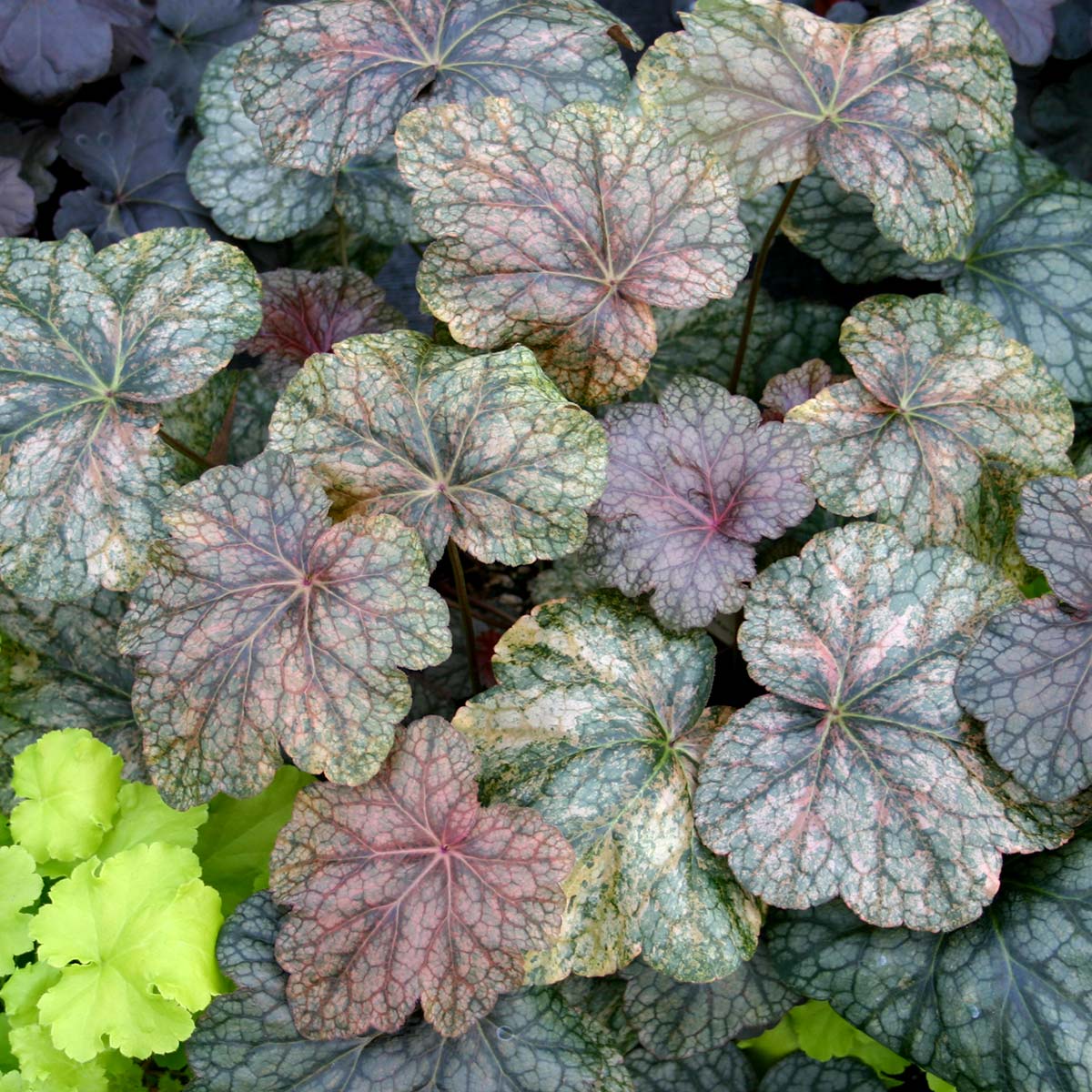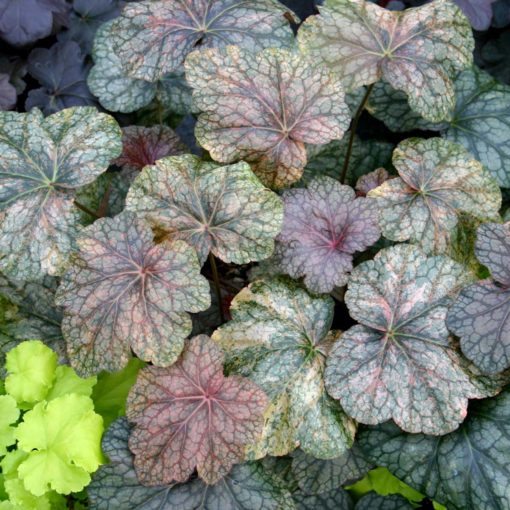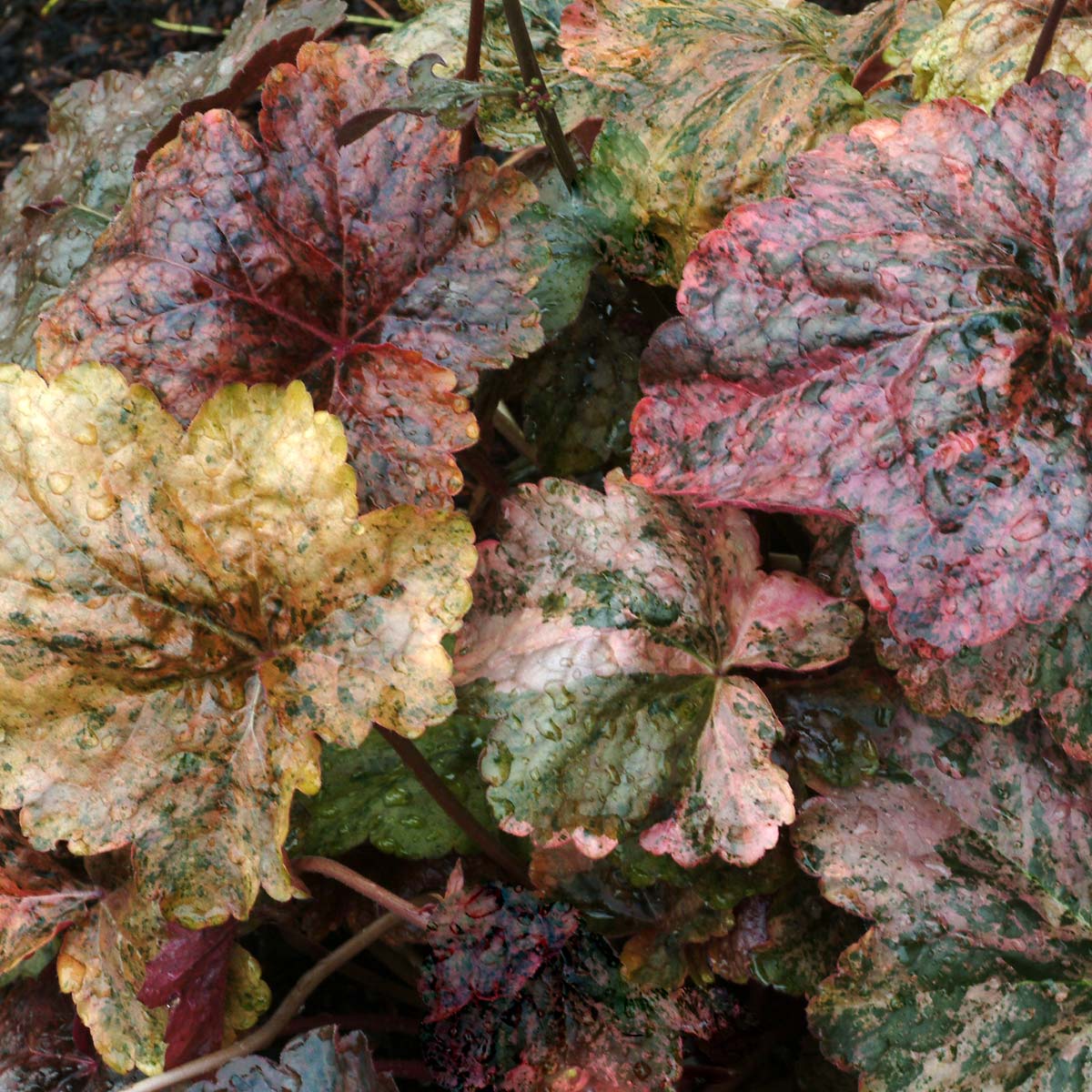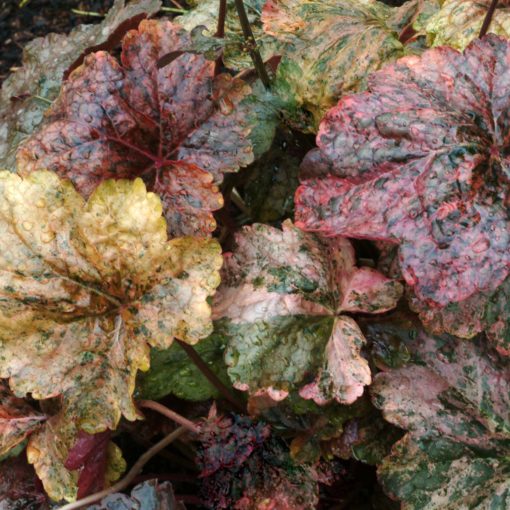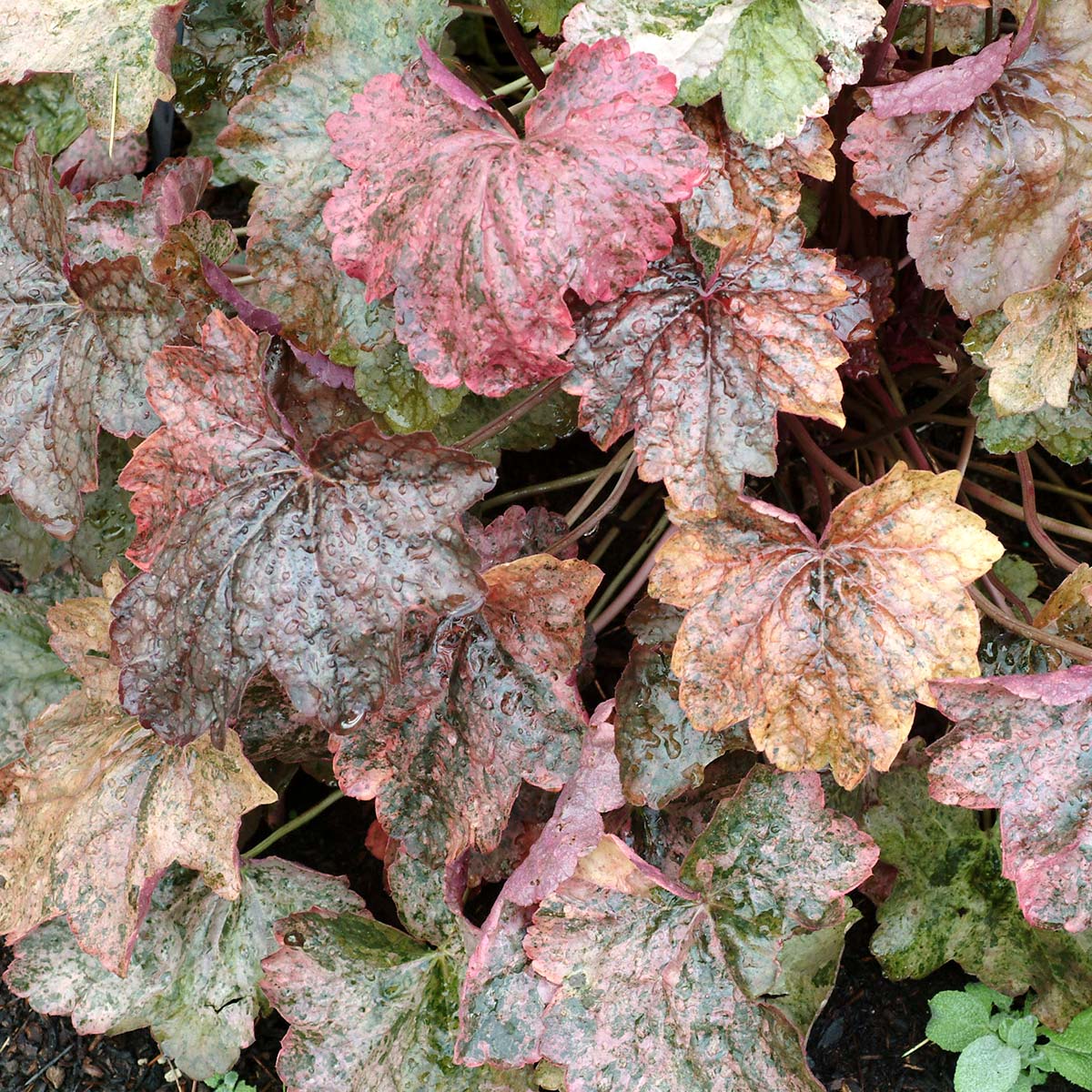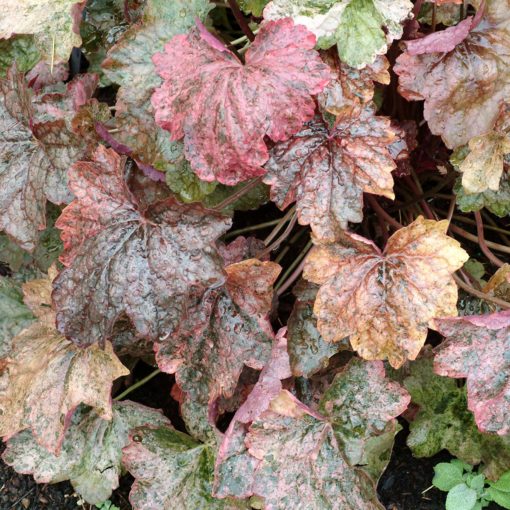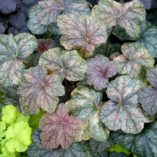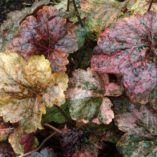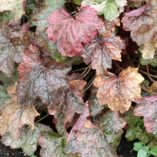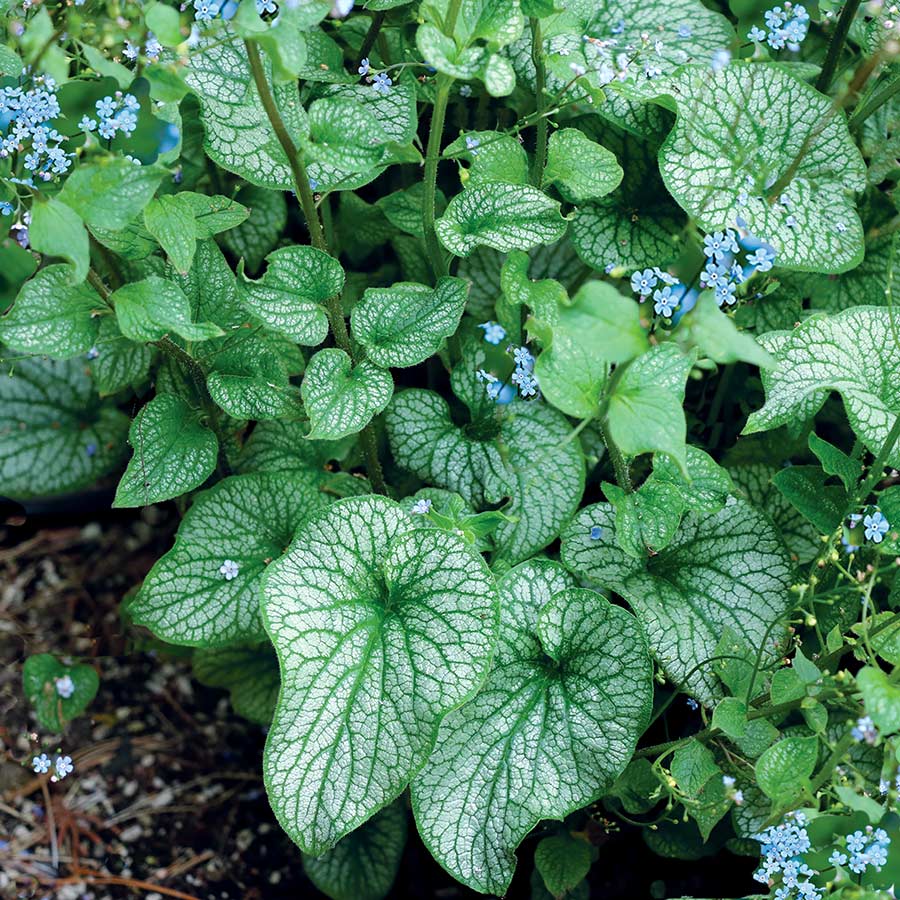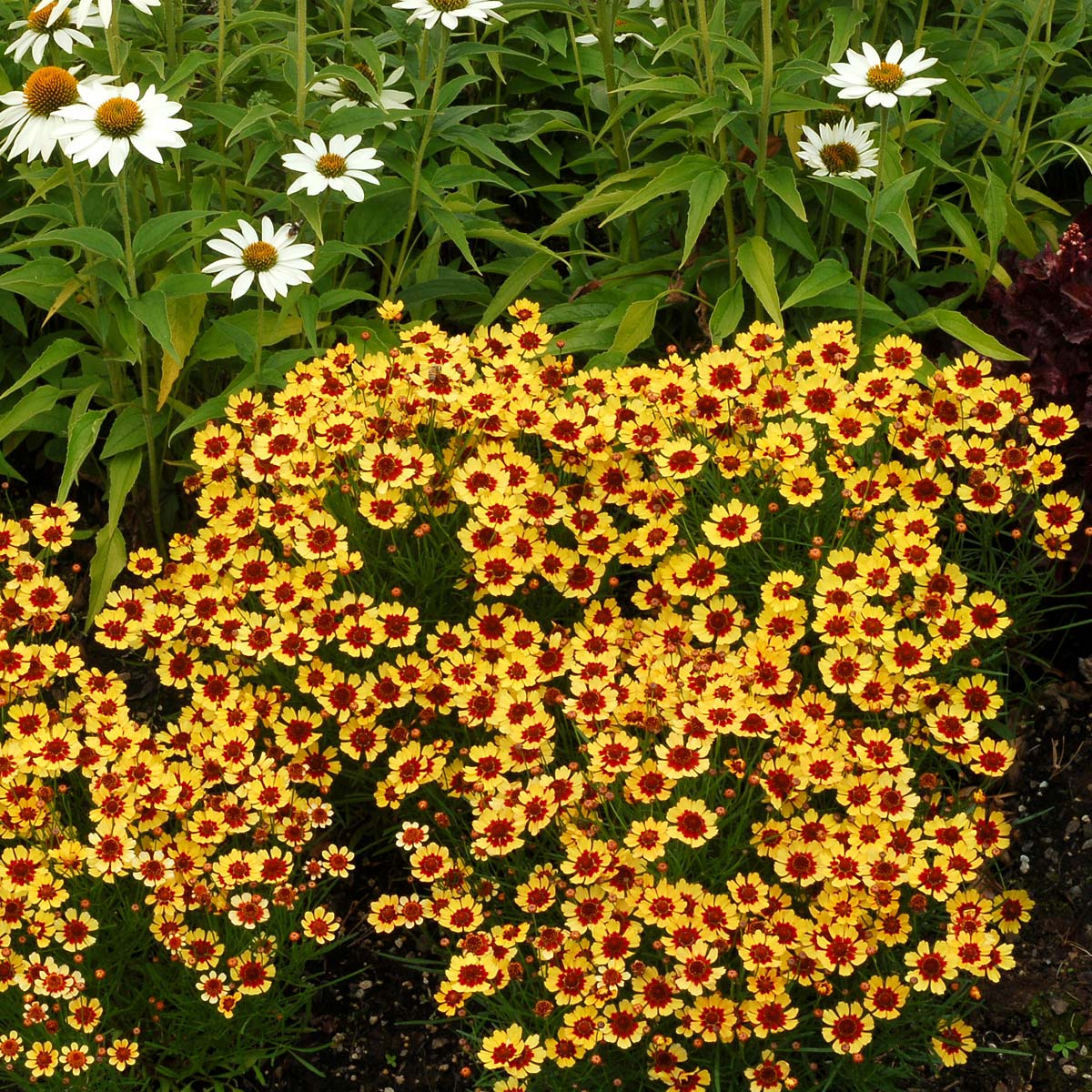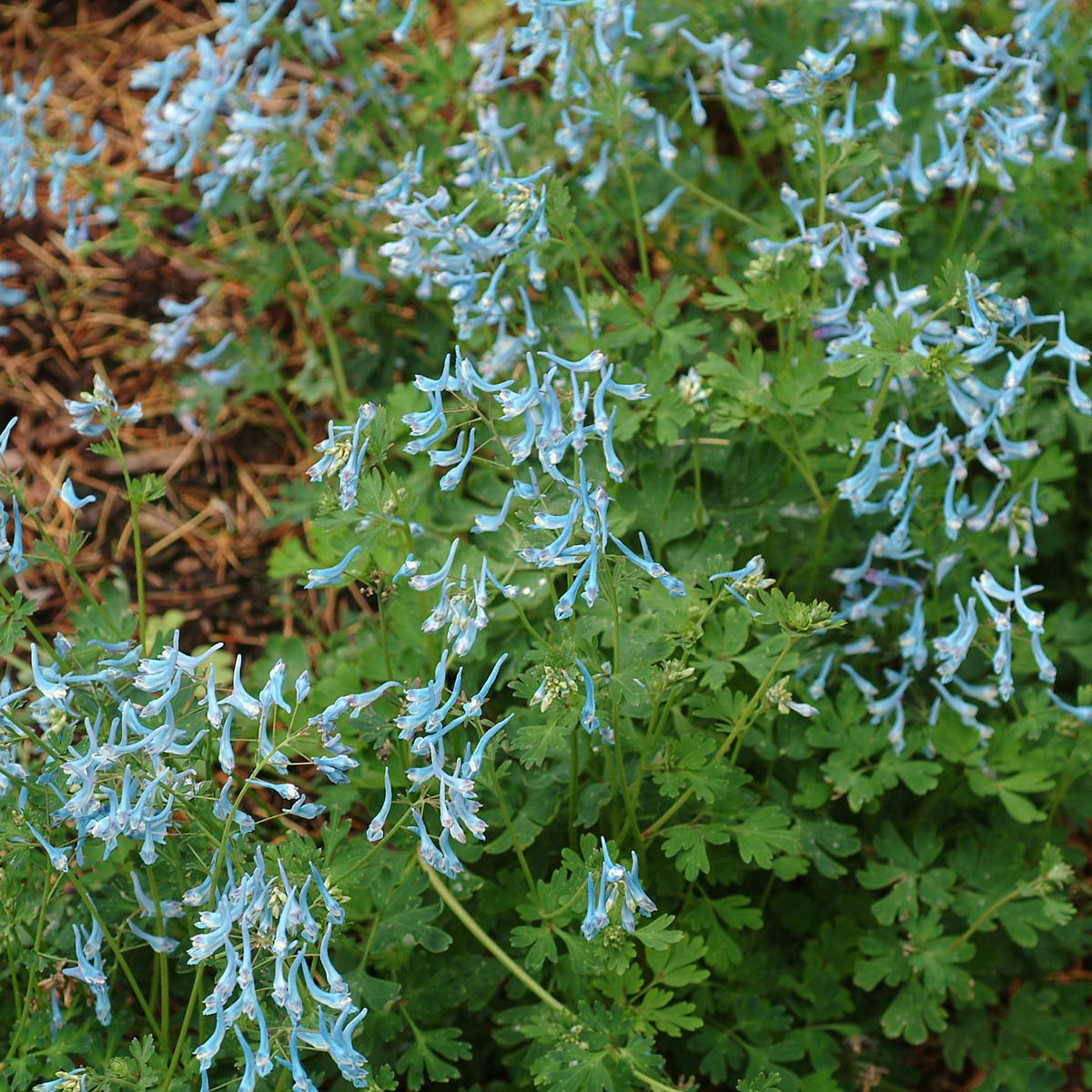| Common Name | Coral Bells |
|---|---|
| Family | Saxifragaceae |
| Genus | Heuchera |
| species | -- |
| Plant Type | Perennial |
| US Patent # | -- |
| EU Grant # | -- |
| Bloom Time | May, June |
| Flower Color | -- |
| Foliage Color | Green, Orange, Pink, Silver |
| Dormancy | Winter |
| Exposure | Part Shade |
| Growth Habit | Mounding |
| Growth Rate | Moderate |
| Hardiness Zone | 4, 5, 6, 7, 8, 9 |
| How Different? | Large dark leaves with variegation. |
| Landscape Value | Edging, mass. |
| Most Active Growing Season | Spring |
| Persistence | Evergreen |
| Size (HT/W/FL HT) | 17" / 18" / 36" |
| Soil (Garden) | Moderately well drained, organic soil types are best. |
| Water (Garden) | Average, better too dry than too wet when established. |
| Special Uses | Hummingbird Attractor, Low Water Usage, Pollinator Attractor, Winter Color |
| Comments | Lift and replant in late summer or early autumn every few years with the crown just above the soil. |
Heuchera ‘Mardi Gras’
|
*** PLEASE NOTE ***
This plant is no longer for sale directly from TERRA NOVA® Nurseries. However, it may still be available through one of our Licensees or Retail Sources. |
This is a stunningly different plant with huge leaves reflecting a changing palette of variegation from coral to orange to green to gray. Every plant is different and colors up on its own time.
USDA Hardiness Zone(s): 4-9
Size (HT/W/FL HT): 17″ / 18″ / 36″
Exposure: Part Shade
Bloom Time(s): May, June
| Water (Greenhouse) | Dry moderately between waterings. |
| EC | 0.6 – .09 |
| pH | 5.5 – 6.5 |
| Fertility Needs | 100 – 150 ppm |
| Notes | Be careful not to bury the crowns when planting. |
| Finish Time to 4″ | 4 – 6 weeks |
| Finish Time to Gallon | — |
| Day Length for Flowering | Long Neutral |
One of the easiest perennials to grow, coral bells are virtually carefree. Here are the basics:
• Hardy in USDA zones 4-9, coral bells are tolerant of a wide range of light conditions, poor soil, heat, cold, humidity and drought.
• Foliage comes in nearly every color imaginable, from silver to nearly black. Leaves are patterned, ruffled, wavy or smooth.
• Flowers occur in hues of coral, red, white or pink and are attractive to butterflies and hummingbirds, and are long-lasting in cut arrangements.
Planting
Plant coral bells in spring or fall. Space plants 1-2 feet apart.
Culture
Light: Coral bells can be grown in a wide range of light conditions, from full sun to shade. Foliage color and bloom are best when plants receive at least 4-6 hours of direct sunlight.
Soil: Heuchera does best in rich well-draining soil, but is tolerant of clay or rocky soils and salt. If you have heavy clay garden soil, amend it to improve the drainage before planting your new coral bells or plant them in a raised bed.
Fertilizer/Watering: Keep soil evenly moist but not soggy. Heuchera is somewhat drought-tolerant once established. Provide extra water during hot spells. In spring, spread a thin layer of compost or apply a balanced slow-release granular fertilizer around the base. For container-grown plants, supplement with a water-soluble fertilizer according to instructions.
Pruning: Trim back tattered foliage in early spring.
Pots: Coral bells grow beautifully in containers. Just make sure there is a hole in the bottom where the excess water can drain from. Transplant into the landscape in early fall if you’d like them to come back again next year. If you garden in zones 6b or warmer, they can be overwintered in containers.
Varieties with lighter colored leaves, like yellow or soft peach, need more shade to protect them from sun scorch. Plant them in morning sun or full shade.
Varieties with near-black foliage or another saturated color can handle more sun. In cooler growing regions, they will even grow in full sun if given enough moisture.
Coral bells with especially fuzzy leaves tend to prefer less water and be more heat tolerant than those with shiny leaves. Those are good choices to plant in warmer climates and in places where the soil tends to be a bit drier.
Some varieties of coral bells change colors throughout the year. Spring and fall weather tends to make the colors brighter while the summer’s heat may encourage a light silvering to develop on some varieties. This is perfectly normal and should not be a cause for concern.
Some varieties of coral bells produce showy flowers while others are grown strictly for their foliage. When shopping, read the plant label to know whether you should expect showy blooms to appear.
Varieties that produce flowers can be used as cut flowers in fresh bouquets. The flower stems are typically long and strong enough for cutting and the flowers last several days. The leaves of coral bells can also be used in small arrangements.
Bees, butterflies and hummingbirds are attracted to coral bells with vibrant red or pink flowers.
Heuchera goes well with many other perennials, trees and shrubs.
For shady locations, combine with other woodland plants such as astilbe, bleeding heart, ferns, hellebores, hosta, Japanese forest grass and lamium.
For sunny sites, plant alongside artemisia, bugleweed, daylilies, geranium, iris, lady’s mantle, lysimachia and ornamental grasses.
Do heucheras die back in winter?: Coral bells are evergreen in warmer regions and semi-evergreen in colder climates.
Should you cut back heuchera?: If foliage looks ragged, cut plants back in early spring to stimulate fresh new growth. Remove any dead or damaged foliage as needed. Cut back spent flower stalks to encourage rebloom.
Is it recommended to cut coral bells back in the fall?: It is not recommend. Most heuchera remain evergreen in the majority of growing zones in the US. Exceptions are the lower zones 4-6, when little snow cover is available to protect the foliage from drying winter winds.
If not, what are the reasons not to and when should they be trimmed?: Unnecessarily removing perfectly good foliage reduces the amount of food that leaves make for the plant that sustains it during winter. Removing the leaves also exposes the crown of the plant, typically the most tender part of the plant. Even leaves that have dried on the plant help guard the crown. Heucheras can be trimmed if they are sending up only one stemmy crown, like one would "pinch" a growth tip of just about any plant to make it branch. Removing dead foliage is always appropriate any time of the year.
Any tips for cutting back coral bells?: Use sharp, clean shears to make any cuts, they heal faster that way. Disinfect the shears with rubbing alcohol between each plant. Prune, or pinch just before spring growth begins. Discolored foliage may just be the result of a cold snap, or conversely an overly warm stretch of weather. If foliage is affected by Heuchera rust, Pucinnia huecherae, remove the effected foliage and throw it into the garbage. Composting it at your own home isn’t removal, it’s incubation. Heuchera rust comes in on the wind and is spread by rain splashing on the foliage.
Are heucheras perennials?: Heucheras are reliable perennials in most regions.
What is the best place to plant coral bells?: Heucheras are native to North American woodlands, prairies and mountain regions. They will thrive in conditions that simulate their native habitat.
How much water do they need?: Coral bells prefer moist, well-drained soil. Soggy, wet soil, especially over the winter months, kills more coral bells than cold temperatures. Don’t plant them where you pile your snow for the winter.
Can coral bells be planted in full sun?: The ideal conditions for coral bells is part shade, meaning 4 to 6 hours of direct sunlight per day, and out of the way of scorching afternoon sun. However, heuchera plants will grow in any amount of sunlight, including full sun, as long as you water well. If the foliage starts to turn brown with crispy edges, it is probably getting too much sun and should be moved to a shadier location.
How big do heucheras get?: Coral bells have a mounding habit, growing 6-16 inches tall and 12-36 inches wide. Flower spikes reach 1-3 feet tall.

